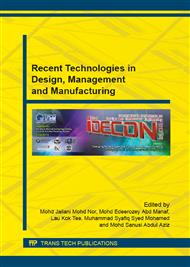[1]
M.C. Shaw, J.D. Pigott, L.P. Richardson, Effect of cutting fluid upon chip–tool interface temperature, Trans. ASME 71 (1951) 45–56.
DOI: 10.1115/1.4016140
Google Scholar
[2]
S. Paul, N.R. Dhar, A.B. Chattopadhyay, Beneficial Effects of Cryogenic Cooling over Dry and Wet Machining on Tool Wear and Surface Finish in Turning AISI-1060 Steel, ICAMT-2000, pp.209-214, Aug (2000).
DOI: 10.1016/s0924-0136(01)00839-1
Google Scholar
[3]
C. Cassin, G. Boothroyed, Lubrication action of cutting fluids, J. Mech. Eng. Sci. 7 (1) (1965) 67–81.
Google Scholar
[4]
E. Kalhofer, Dry Machining-Principles and Applications, Second Seminario Inter. de Alta Tecnologia, p.519–526, Jul (1997).
Google Scholar
[5]
N. King, L. Keranen, K. Gunter, and J. Sutherland, Wet Versus Dry Turning: A Comparison of Machining Costs, Product Quality, and Aerosol Formation, SAE Paper, 2001, SP-1579.
DOI: 10.4271/2001-01-0343
Google Scholar
[6]
S.A. Lawal, I.A. Choudhury, Y. Nukman, Application of vegetable oil-based metalworking fluids in machining ferrous metals—A review, Int. J. Mach. Tools Manuf. 52 (2012) 1-12.
DOI: 10.1016/j.ijmachtools.2011.09.003
Google Scholar
[7]
F. Klocke, G. Eisennblatter, Dry cutting, CIRP Ann. 46 (2) (1997) 519-526.
Google Scholar
[8]
F. Klocke, G. Eisenblatter, Coated tools for metal cutting-features and applications, CIRP Ann. 48 (2) (1999) 515-525.
DOI: 10.1016/s0007-8506(07)63231-4
Google Scholar
[9]
U. Heisel, M. Lutz, Application of minimum quantity cooling lubrication technology in cutting processes, Prod. Eng. II. 1 (1994) 49-54.
Google Scholar
[10]
J.W. Sutherland, An experimental investigation of air quality in wet and dry turning, CIRP Ann. 49 (1) (2000) 61–64.
DOI: 10.1016/s0007-8506(07)62896-0
Google Scholar
[11]
S. Suda, H. Yokota, F. Komatsu, I. Inasaki, T. Wakabayashi, Evaluation of Machinability with MQL System and Effectiveness in Production Lines, International Tribology Conference, pp.230-235, (2000).
DOI: 10.1299/jsmemmt.2000.2.171
Google Scholar
[12]
J. McCabe, M.A. Ostaraff, Performance experience with near-dry machining of aluminum, Lubr. Eng. (2001) 22–27.
Google Scholar
[13]
U. Heisel, D. Lutz, R. Wassmer, U. Walter, The Minimum Quantity Lubricant technique and its application in the cutting process, Machines and metals magazine, Brazil, No. 386, pp.22-38, Feb. (1998).
Google Scholar
[14]
T.F. MaClure, R. Adams, M.D. Gugger, Comparison of flood vs. microlubrication on machining performance, Information on http: /www. unist. com/techsolve. html.
Google Scholar
[15]
H.K. Tonshoff, W. Spintig, W. Konig, A. Neises, Machining of holes developments in drilling technology, CIRP Ann. Manuf. Technol. 43 (1994) 551-561.
DOI: 10.1016/s0007-8506(07)60501-0
Google Scholar
[16]
M.M.A. Khan, M.A.H. Mithu, N. R. Dhar, Effects of minimum quantity lubrication on turning AISI 9310 alloy steel using vegetable oil-based cutting fluid, J. Mater. Process. Technol. 209 (2009) 5573-5583.
DOI: 10.1016/j.jmatprotec.2009.05.014
Google Scholar
[17]
A. Attanasiao, M. Gelfi, C. Giardini, C. Remino, Minimum Quantity Lubrication in turning, Wear. 260 (2006) 333-338.
DOI: 10.1016/j.wear.2005.04.024
Google Scholar
[18]
E. Lugscheider, O. Knotek, C. Barimani, T. Leyendecker, O. Lemmer, R. Wenke, Investigations on hard coated reamers in different lubricant free cutting operations, Surf. Coat. Technol. 90 (1997) 172-177.
DOI: 10.1016/s0257-8972(96)03114-3
Google Scholar
[19]
A. Demirbas, Relationships derived from physical properties of vegetable oil and biodiesel fuels, Fuel. 87 (2008) 1743-1748.
DOI: 10.1016/j.fuel.2007.08.007
Google Scholar
[20]
L.B. Abhang, M. Hameedullah, The Measurement of chip-tool interface temperature in the turning of steel, Int. J. Comput. Commun. Inf. Syst. 2 (2010) 1-5.
Google Scholar


